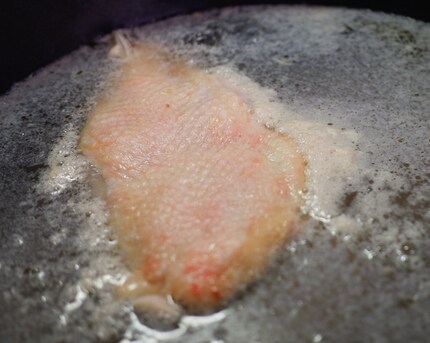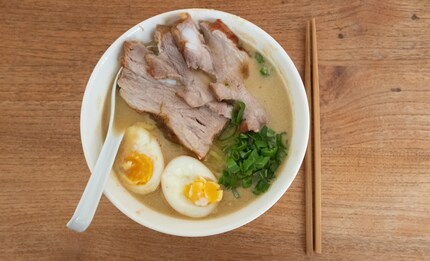
Guide
The first two weeks of "Schnitz und Drunder"
by Simon Balissat
Every day from 11 a.m., we cook together in the YouTube cookery show "Schnitz und Drunder". The show is named after a typical dish from Aargau, a bit of home for me as an exile from Baden in Zurich. This week we're cooking "ramen" like in Japan.
Tenkaippin is a restaurant chain in Japan that serves a particularly chewy, hearty chicken broth. While restaurant chains have a bad reputation here and are frowned upon, in Japan they are a sign of quality. This quality has to be right in every single restaurant. If the customer is served a bad dish, it can mean the end. Tenkaippin itself has stumbled across such a scandal. Instead of serving Japanese spring onions - as stated on the menu - Chinese spring onions were mistakenly served. The scandal illustrates the importance restaurants in Japan place on the preparation of their dishes.
Tenkaippin was the last bowl of ramen I ate on my trip to Tokyo. My friends Abe and Mao were hesitant at first. The soup was very special, they said. They didn't know if I would like it. I insisted on visiting the restaurant with the "muddy" soup. "Muddy" was the mobile phone translation for the Japanese description of the soup. It was great, with a viscous consistency. Very hearty at first, but then light on the finish with a hint of root vegetables. I have now been cooking for three days in my attempt to imitate the soup. I'm still not completely satisfied with the result. Do you think three days is too much effort? It took the founder of Tenkaippin four years to optimise his soup.
I split the recipe into two episodes and do it in a different order to the videos because it's easier then.
** Tare seasoning sauce **
Bring everything to the boil and simmer gently for half an hour, then cool and place in the fridge. Strain on day 2 and set aside.
** Roast pork chashu **
Broil the pork breast on both sides in a casserole, deglaze with liquid, add the ginger and spring onions and cover with double aluminium foil as a "lid". Turn the roast every 15 minutes and braise until the liquid is syrupy, about 90 minutes. Then leave the roast to cool and place in the fridge. Keep the stock.
** Ramen eggs **
Place the eggs with the marinade in a sealable bag and marinate overnight in the fridge
You can also start the soup the day before if you don't have a whole day to prepare it.
Cut a soup chicken into small pieces, cutting through the bones as the inside of the bones makes the soup really creamy. Leave the chicken pieces to rest in cold water for three hours, drain the water and remove any dark red or brown bits. - Boil the chicken pieces in fresh water in a large pan and remove the resulting foam and particles from the surface with a slotted spoon or kitchen paper. Simmer for 6 hours, adding water if necessary and repeatedly pounding the chicken pieces so that they fall apart


Itadakimasu and bon appétit!
And here's another gentleman who eats six bowls of soup at Tenkaippin and suffers afterwards. That could be me.
When I flew the family nest over 15 years ago, I suddenly had to cook for myself. But it wasn’t long until this necessity became a virtue. Today, rattling those pots and pans is a fundamental part of my life. I’m a true foodie and devour everything from junk food to star-awarded cuisine. Literally. I eat way too fast.
Practical solutions for everyday problems with technology, household hacks and much more.
Show all